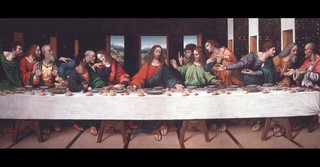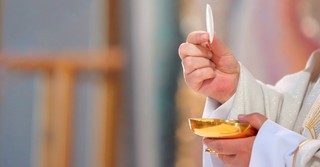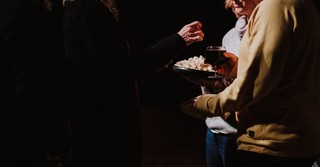What Is Communion and Why Is it Celebrated Differently?
Share

Pieces of bread or hard little wafers. Wine or Welch’s. Or maybe you get fancy with sparkling grape juice. Weekly, monthly, or hardly ever. Communion is celebrated in Christian churches around the world, but it’s more than a mid-sermon snack. So, what is it actually? And why is it celebrated so many different ways?
The Lord's Supper is also called "the Lord's table" (1 Corinthians 10:21), "communion," "cup of blessing" (1 Corinthians 10:16), and "breaking of bread" ( Acts 2:42 ). In the early Church it was called also "eucharist," or giving of thanks (Matthew 26:27), and generally by the Latin Church "mass," a name derived from the formula of dismission, Ite, missa est, i.e., "Go, it is discharged."
What is Communion?
The account of the institution of this ordinance is given in Matthew 26:26-29 , Mark 14:22-25 , Luke 22:19 Luke 22:20 , and 1 Corinthians 11:24-26 . It is not mentioned by John.
It was designed:
1. To commemorate the death of Christ: "This do in remembrance of me."
2. To signify, seal, and apply to believers all the benefits of the new covenant. In this ordinance Christ ratifies his promises to his people, and they on their part solemnly consecrate themselves to him and to his entire service.
3. To be a badge of the Christian profession.
4. To indicate and to promote the communion of believers with Christ.
5. To represent the mutual communion of believers with each other.
The elements used to represent Christ's body and blood are bread and wine. The kind of bread, whether leavened or unleavened, is not specified. Christ used unleavened bread simply because it was at that moment on the paschal table. Wine, and no other liquid, is to be used ( Matthew 26:26-29 ). Believers "feed" on Christ's body and blood, (1) not with the mouth in any manner, but (2) by the soul alone, and (3) by faith, which is the mouth or hand of the soul. This they do (4) by the power of the Holy Ghost. This "feeding" on Christ, however, takes place not in the Lord's Supper alone, but whenever faith in him is exercised. (Easton's Bible Dictionary)
Origin and History of Communion

Communion was instated by Jesus Himself. The story is recounted in Matthew, Mark, and Luke. Take a look at the following passage:
“While they were eating, Jesus took bread, and when he had given thanks, he broke it and gave it to his disciples, saying, ‘Take and eat; this is my body.’
Then he took a cup, and when he had given thanks, he gave it to them, saying, ‘Drink from it, all of you. This is my blood of the covenant, which is poured out for many for the forgiveness of sins’” (Matthew 26:26-28).
Jesus uttered these words at the last meal He shared with His disciples before His death. It was the Passover, a time during which the Jews commemorated their escape from slavery in Egypt, and it was an important meal.
The twelve disciples were gathered with Jesus, and it was a somber time, though the disciples didn’t quite understand why. He foretold His death, and His betrayal by Judas. However, He had also foretold that His death would be “a ransom for many” (Mark 10:45). In this ritual of breaking the bread and taking the cup, Jesus was reminding His disciples of what He was about to do.
As early as Acts 2, early Christians are recorded “breaking bread” with one another. In 1 Corinthians 11:17-34, Paul gives specific directives for celebrating what he calls “The Lord’s Supper.”
Communion, then, was not a ritual produced by later Christians, but something instituted immediately. It has been celebrated ever since. From the 2nd century writings of Justin Martyr to the Fractio Panis fresco depicting believers partaking in communion, history shows that the early church was committed to the Lord’s Supper.
In the fourth century, Emperor Constantine the Great converted to Christianity, effectively ending the state persecution of Christianity. This caused Christianity to come into vogue. The Roman Catholic Church grew in power and split with the Eastern Church in 1054, an event that came to be known as the Great Schism and is explained more here by Encyclopedia Britannica. The Catholic church continued to grow until by the Middle Ages it was the most powerful political and spiritual entity in Europe. Even kings bowed to the pope, and the threat of excommunication and not being able to partake in the Eucharist (communion) was enough to drive monarchs to their knees.
As one of the sacraments of the Roman Catholic Church, the Eucharist was administered by priests. However, with the Protestant Reformation and the birth of Protestant ideology, communion began to change once more for those who adhered to Protestantism. As Protestants fractured into dozens of denominations, various ways of taking communion developed, until today where we have a multitude of traditions, from the wine-vs-grape-juice debate, to the frequency of partaking, to church membership mandates, to the communal goblet vs. little plastic cups.
Photo credit: Wikimedia/Leonardo Da Vinci/Public Domain Image
What Is the Purpose of Communion?

Jesus told us why we celebrate communion when He instated it. He said, “Do this… in remembrance of me” (1 Corinthian 11:25).
When we take communion, we are remembering Jesus’ sacrifice on the cross. The bread and wine are tangible, visible reminders of Christ’s love. Rather than simply saying “remember,” Jesus gave us a reminder. Just as we depend on food and drink to live physically, we can only live spiritually through Christ.
Communion is a time of just that: communing. It is a chance to bring ourselves before the Lord and partake in the life He has given us through His death and resurrection.
Communion is also a time to be in community with fellow believers, past and present. As an ordinance that has stretched from the original disciples to twenty-first century believers and is celebrated all over the world, it brings us together as the body of Christ.
We should also take the time to examine ourselves to ensure that our relationship with Christ is authentic and genuine. Not only recalling the inauguration of our relationship with Christ, but also seeking to discover if there is any unconfessed sin impeding our current fellowship with God (1 John 1:6–9).
Lastly, we would be remiss to ingest these symbols of Christ without a heart that is purposefully thankful. Paradoxically, the Lord’s Supper is not only a reminder of his brutal death, but it is also a celebration of the incredibly generous grace of God and the invaluable privilege of being forgiven.
Photo credit: Getty Images/PIC2FRAMES, Except from Examine Yourself Before Communion
Different Ways of Celebrating Communion

Different churches and traditions celebrate communion diversely. There are three main ways: through a common cup from which all drink, through intinction (dipping the bread into the communal cup), or through the offering of individual cups and pieces of bread/wafers.
Below are some of the ways different groups of Christians have celebrated communion, and their reasons why:
Roman Catholic Church:
To receive communion, or Eucharist, in the Roman Catholic Church, one must be in a “state of grace,” meaning one has not committed any “mortal sins” since last confessing. This requirement is drawn from an interpretation of 1 Corinthians 11:27-28 to not partake in an unworthy manner.
A person must then believe in the doctrine of transubstantiation, which is explained by Catholic Answers as the Roman Catholic belief that the bread and wine are “transformed into the actual body, blood, soul, and divinity of Christ, and only the appearances of bread and wine remain.” This comes from the interpretation that when Jesus said, “this is my body” and “this is my blood,” He meant it literally.
A person also must not have eaten or drank anything besides water (with the exception of medicine) for an hour before partaking. Finally, they must be in good standing with the Catholic Church. Partakers receive the Eucharist from an ordained priest.
Only Catholics and sometimes Orthodox believers may partake.
Orthodox Church
The Orthodox Church also calls for fasting before communion, making the partaker “hungry for God.” It calls for confession of sins to God, so as not to partake in an unworthy manner (1 Corinthians 11:27).
Great care is given to honor the sacred nature of the elements, as shown in this excerpt from the Greek Orthodox Metropolis of San Francisco:
“When we come before the priest for Holy Communion, our hands should not be in our pockets, but at our sides. We make the sign of the cross, tell the priest our baptismal name, hold the Communion cloth carefully under our chin, and open our mouth wide. We do not slurp from the spoon, nor should our teeth scrape on the spoon. After receiving Communion we wipe our lips carefully with the Communion cloth (not on our hand or shirtsleeve), make the sign of the cross, and hand the Communion cloth to the next person.
We are always careful that we do not allow Communion to fall from the communion spoon or from our lips onto our clothing or to the floor. For this reason we move very slowly toward the chalice and the communion spoon, and we do not pull our head away quickly after receiving. We are careful not to bump the chalice or the hand of the priest. After receiving Communion, we do not chew gum (or spit), because when we dispose of our gum it may contain particles of Holy Communion.”
Only Orthodox Christians may partake.
Protestant Churches
This is where it is no longer easy to state what even a majority of Protestant practices. Though the above can’t necessarily be true of all Roman Catholics or all Orthodox believers, the structured and liturgical nature of these churches makes it more uniform.
Not so much for the myriad denominations of Protestants.
Some, like Episcopalians, usually use actual wine and communal cups, like Catholic and Orthodox believers. More liturgical churches like the Anglican, Episcopalian, and Lutheran congregations tend to receive communion from church leaders, perhaps kneeling at the altar.
Others, like Baptists, stick to grape juice. Baptist and nondenominational churches often tend to pass around a tray of the elements or allow congregation members to approach tables and self-serve. This stems from a greater focus on an individual’s direct interaction with God, rather than a person approaching the communion through the mediation of a priest or pastor.
Most, though not all, Protestant congregations practice “open communion,” in which anyone who is a believer may partake in communion.
Photo credit: wideonet
What Is the Right Way to Take Communion?

Jesus didn’t give very many specifics on how to take communion. Instead, He gave an object lesson to His disciples: See how this bread and drink are necessary to bring you life? In the same way, I will give you life.
As shown above, churches have reasons for differences in celebration. Often, it is a difference of emphasis: The Orthodox Church gives extreme care to honoring the physical elements in order to honor Christ, while most Protestants focus on directing internal thoughts and prayers to God and see the elements as more of a metaphor. The Catholic Church focuses on coming to the Lord’s Supper pure of sins, while Protestant congregations often call worshipers to repentance through communion.
There are hundreds and thousands of resources out there from all of the different traditions, outlining reasoning for celebrating communion one way or another. Each offer interesting perspectives on communing with God and honoring Christ. However, at the end of the day, we all agree: communion is a powerful way to remember Christ’s sacrifice and show our devotion to Him.
Photo credit: Unsplash/Priscilla Du Preez
Alyssa Roat is a literary agent at C.Y.L.E., a professional writing major at Taylor University, and a freelance editor with Sherpa Editing Services. Her passions for Biblical study and creativity collide in her writing. More than a hundred of her works have been featured in publications ranging from The Christian Communicator to Keys for Kids. Find out more about her here and on social media @alyssawrote.